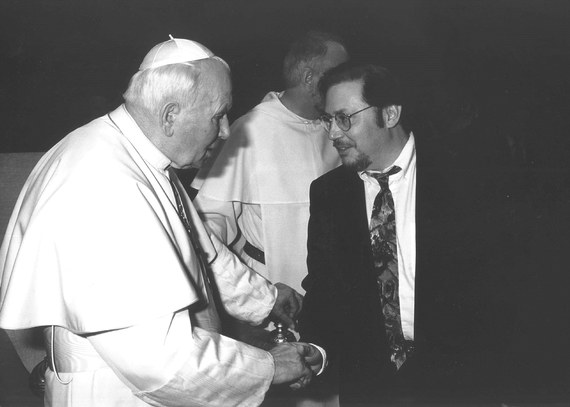I first met Pope John Paul II in 1995 during a special Saturday night meeting with Cardinal John O'Connor and a group of New York Jewish leaders at St. Patrick's Cathedral.
I had never seen Manhattan this deserted before, (pre-9/11). Midtown was eerily dark and quiet. A blocks-long police "frozen-zone" enveloped the great Cathedral. No cars or pedestrians were allowed without a special pass. Walking towards St. Pats, if you looked up at the skyscrapers at just the right angle, you could catch a glimpse of the police sharpshooters, rifles primed for any potential trouble.
But inside the Cardinal's residence, the atmosphere meeting was warm and intimate, like a group of friends gathered for a dinner party. John Paul was charismatic and witty. He shook everyone's hand and expressed his desire to visit Jerusalem soon -- a feat which took another five years to accomplish.
After the meeting, I somehow became the only guest left standing outside the Cardinal's residence. Police directed me to keep perfectly still -- pointing to the sharpshooters -- until the pope was safely inside his car. Before he entered the sleek black limo, John Paul saw me, paused and waved.
My next encounter with the Polish pope was at the Vatican in 1998. By then, signs of his illness were readily apparent. For this meeting, I had learned a few words of Polish, the language of my maternal grandfather. So when my turn to meet the Pope came, I greeted him in Polish. His eyes lit up. He began responding in rapid Polish. When he saw this was beyond me, he kindly switched to English. We discussed my great-grandparents, Jermia and Dina Wizen from Zaklikow, whose entire family -- save my grandfather -- were killed by the Nazis at the Belzec extermination camp, the pilot program for the Auschwitz gas chambers. John Paul expressed great empathy.
And it was in 1998 that the Vatican issued its long-awaited Holocaust document called "We Remember," which grapples with the Church's responsibility and role in the Holocaust -- an issue that continues to be debated to this day.
On March 26, 2000, working as a New York City newspaper reporter, I covered John Paul's historic trip to the Holy Land, featuring events in Amman, Jerusalem, Galilee and Bethlehem. It marked the first official visit by a pope to the State of Israel. I was an eyewitness to the highlight, which occurred at the Temple Mount -- an image widely transmitted around the globe via Internet, TV and countless newspaper photographs.
With the aid of a cane, the stooped 79-year-old pontiff stood alone in the cool shadow of the Western retaining wall of the Jerusalem Temple. God's representative to a billion Catholics slipped a sheet of paper between the ancient stones of Judaism's holiest site. Then, he asked God for forgiveness for those who have persecuted the Jewish people throughout the centuries.
His historic text read:
God of our fathers, You chose Abraham and his descendants to bring your Name to the Nations: We are deeply saddened by the behavior of those who in the course of history have caused these children of yours to suffer, and asking your forgiveness we wish to commit ourselves to genuine brotherhood with the people of the Covenant.
Building on the foundation laid by last Sunday's other new saint, Pope John XXIII, John Paul arguably did more than anyone in history to repair the torturous attitude of Christians toward Jews. He declared anti-Semitism a sin, talked about God's enduring Covenant with the Jewish people and established diplomatic relations with Israel. He also delivered powerful words about the evils of the Holocaust, 2,000 years of persecution by Christians against Jews, and his determination to forge a new positive relationship with the Jewish people, whom he called "beloved brothers."
This positive new trajectory continued under Pope Emeritus Benedict XVI. Today, Pope Francis is taking the relationship to new heights. Thus, the legacy of reconciliation and interfaith dialogue promoted by the Catholic Church's newly minted saint -- Pope John Paul II -- will live on, to the benefit of all mankind.
Rabbi Eric J. Greenberg is co- editor of "The Saint for Shalom," How Pope John Paul Transformed Catholic-Jewish relations: His Complete Texts on Jews, Judaism and the State of Israel (Crossroads 2011)
